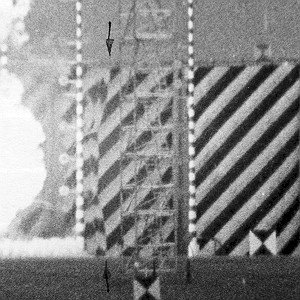
The primary shocks from two identical, separated explosive charges meet to form a complex reflection seen as a vertical refractive image between the two arrows, against a prepared background of striped canvas sails about 50 feet high. The primary shock from the lower charge occupies the centre third of this refractive image and the Mach stem from its reflection at the ground, the bottom third. Its triple point is nearly level with the lowest pressure gauge on the left hand striped pole. Another Mach stem occupies the top third of the image, created when the lower primary shock was reflected from that of the upper charge. Its triple point is seen just below the third-lowest pressure gauge. Because the two charges were identical, detonated simultaneously and separated by a distance equal to twice the height of the lower charge, the two Mach stems can be compared and observed differences in speed, strength, shape, etc., attributed to the nature of the ground surface. Above, the Mach stem at the ground surface lags slightly behind the Mach stem above it, because the ground surface absorbs some of its energy.